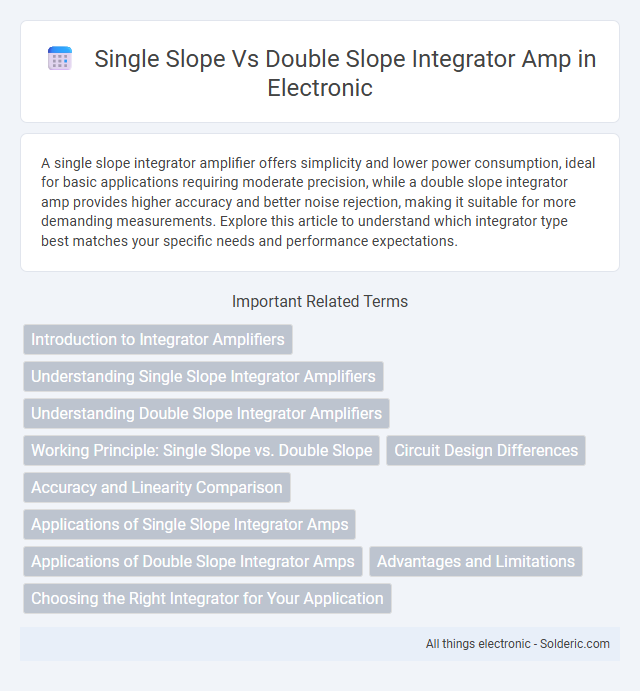A single slope integrator amplifier offers simplicity and lower power consumption, ideal for basic applications requiring moderate precision, while a double slope integrator amp provides higher accuracy and better noise rejection, making it suitable for more demanding measurements. Explore this article to understand which integrator type best matches your specific needs and performance expectations.
Comparison Table
| Feature | Single Slope Integrator Amp | Double Slope Integrator Amp |
|---|---|---|
| Working Principle | Integrates input signal over a fixed time period | Integrates input during run-up and uses a reference during run-down |
| Accuracy | Moderate accuracy, affected by noise and drift | High accuracy due to cancelation of noise and drift |
| Conversion Time | Shorter conversion time | Longer conversion time (dual-phase) |
| Complexity | Simpler circuit design | More complex design with dual slope timing |
| Noise Immunity | Lower noise rejection capability | Higher noise immunity due to dual integration |
| Applications | Basic ADCs, low-cost measurement systems | Precision digital voltmeters, instrumentation ADCs |
| Power Consumption | Lower power consumption | Usually higher due to longer operation time |
Introduction to Integrator Amplifiers
Integrator amplifiers convert input voltage signals into output voltages proportional to their time integrals, playing a crucial role in analog signal processing and control systems. Single slope integrator amplifiers use a single RC feedback network for integration, offering simplicity and moderate accuracy, while double slope integrator amplifiers employ two integration phases for higher precision and noise reduction. The choice between single and double slope integrator amplifiers depends on factors such as required accuracy, speed, and application-specific constraints.
Understanding Single Slope Integrator Amplifiers
Single slope integrator amplifiers use a single ramp signal to convert input voltage into time, providing simpler design and lower component count compared to double slope variants. These amplifiers offer faster conversion speed but are generally less accurate due to susceptibility to noise and offset errors. Understanding single slope integrator amps helps you optimize for applications requiring speed over precision, like basic analog-to-digital conversion or signal processing tasks.
Understanding Double Slope Integrator Amplifiers
Double slope integrator amplifiers use a two-phase process where the input signal is integrated over a fixed period followed by a reference signal integration, enhancing accuracy and noise immunity compared to single slope designs. This technique effectively cancels offset errors and reduces the influence of component variations, making double slope integrators ideal for precise analog-to-digital conversion. Your application benefits from improved resolution and stability, essential in digital multimeters and data acquisition systems.
Working Principle: Single Slope vs. Double Slope
Single slope integrator amplifiers operate by charging a capacitor with the input signal for a fixed time and then discharging it with a reference voltage, measuring the time taken to return to zero to determine the input amplitude. Double slope integrators enhance accuracy by integrating the input signal over a fixed period and then integrating a known reference voltage in reverse direction for a variable period proportional to the input, effectively canceling out noise and offset errors. Your choice between single and double slope depends on the precision and noise immunity requirements of your analog-to-digital conversion application.
Circuit Design Differences
Single slope integrator amplifiers utilize a single ramp signal to integrate the input, leading to simpler circuit design with fewer components and reduced power consumption. Double slope integrator amplifiers incorporate two ramp phases--an initial integration followed by a reference integration--resulting in increased circuit complexity but improved noise immunity and accuracy. The choice between single slope and double slope designs fundamentally impacts the timing control circuitry and overall system performance.
Accuracy and Linearity Comparison
Single slope integrator amplifiers offer moderate accuracy with simpler circuitry but suffer from lower linearity due to inherent noise and drift. Double slope integrator amplifiers achieve superior accuracy and enhanced linearity by utilizing dual integration phases that cancel out errors and mitigate noise effects. This dual-phase approach results in higher precision measurements, especially advantageous in applications requiring stable and repeatable analog-to-digital conversion.
Applications of Single Slope Integrator Amps
Single slope integrator amplifiers are widely used in analog-to-digital converters (ADCs) due to their simplicity and high noise immunity, making them ideal for low-speed, high-resolution applications such as digital voltmeters and temperature sensors. They excel in environments requiring minimal external components and low power consumption, especially in portable and battery-operated devices. Their integration time control allows precise signal processing in instrumentation systems where accuracy is critical.
Applications of Double Slope Integrator Amps
Double slope integrator amplifiers are widely used in analog-to-digital converters (ADCs) due to their high accuracy and noise rejection capabilities, making them ideal for digital voltmeters and precision measurement instruments. These amplifiers integrate the input signal over a fixed interval and then discharge at a known rate, resulting in excellent linearity and minimal offset errors. The robust design of double slope integrators effectively suppresses power line interference, which is crucial for applications demanding precise low-frequency signal processing.
Advantages and Limitations
Single slope integrator amplifiers offer simplicity and lower component count, making them ideal for low-frequency and low-precision applications. Double slope integrator amplifiers provide higher accuracy and better noise rejection by integrating the input signal twice, suitable for precision measurement systems. However, single slope designs often suffer from slower conversion times and more susceptibility to noise, while double slope circuits require more complex timing and control, increasing design complexity and cost.
Choosing the Right Integrator for Your Application
Single slope integrator amplifiers offer simplicity and cost-effectiveness, making them ideal for applications requiring moderate accuracy and slower conversion speeds, such as basic digital multimeters. Double slope integrators provide higher precision and noise rejection by integrating the input signal over two phases, suitable for high-accuracy measurements in precision instrumentation and digital voltmeters. Selecting between these depends on application needs for speed, accuracy, and noise immunity, with double slope excelling in stable, high-precision environments.
single slope vs double slope integrator amp Infographic

 solderic.com
solderic.com